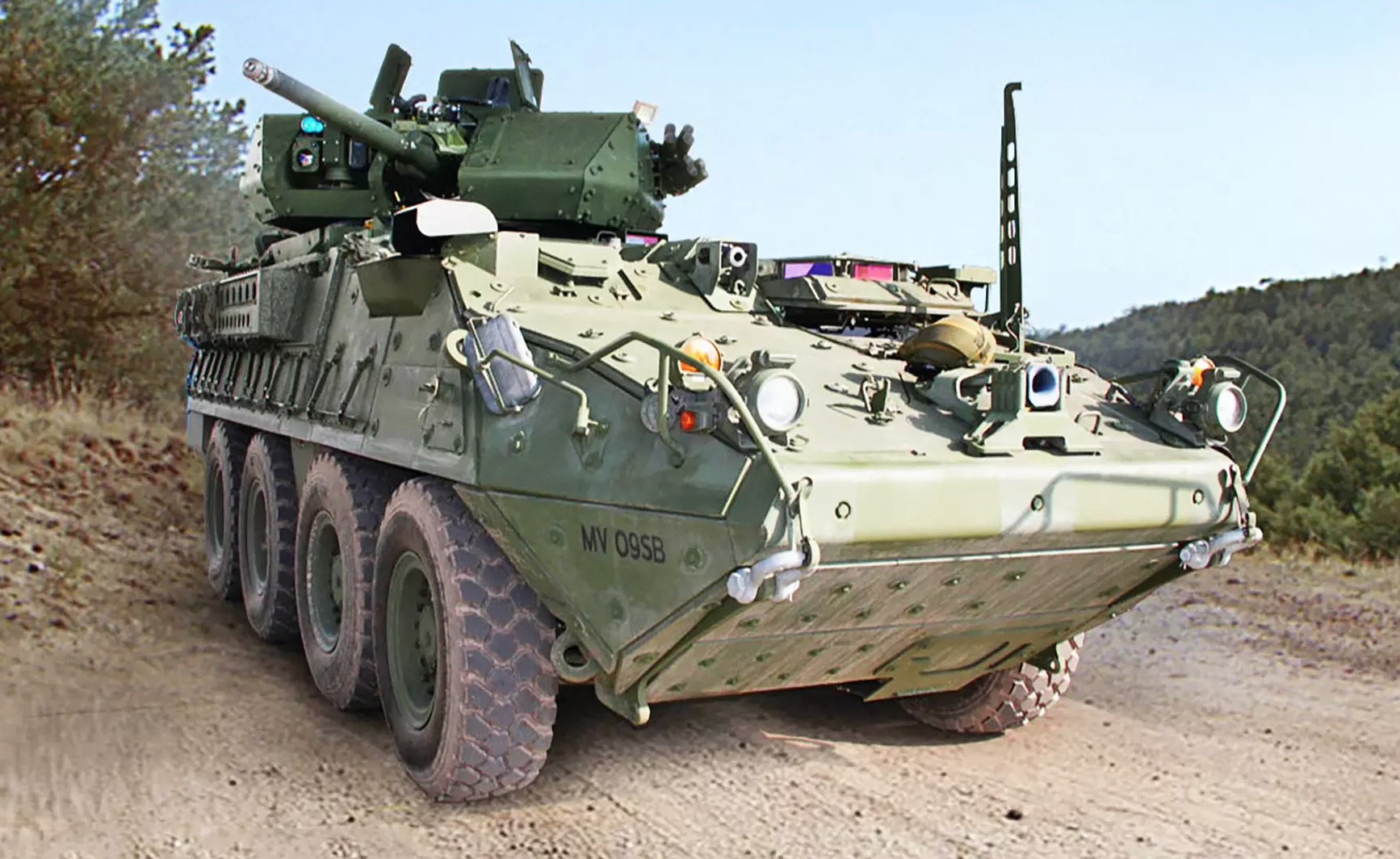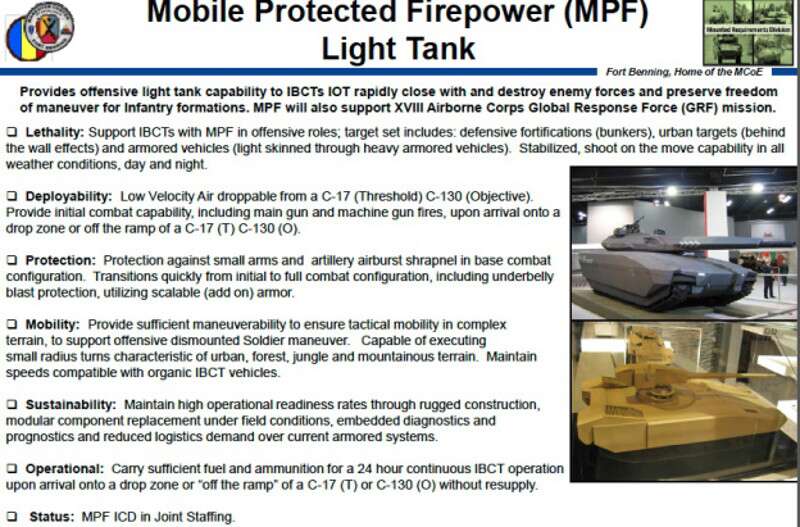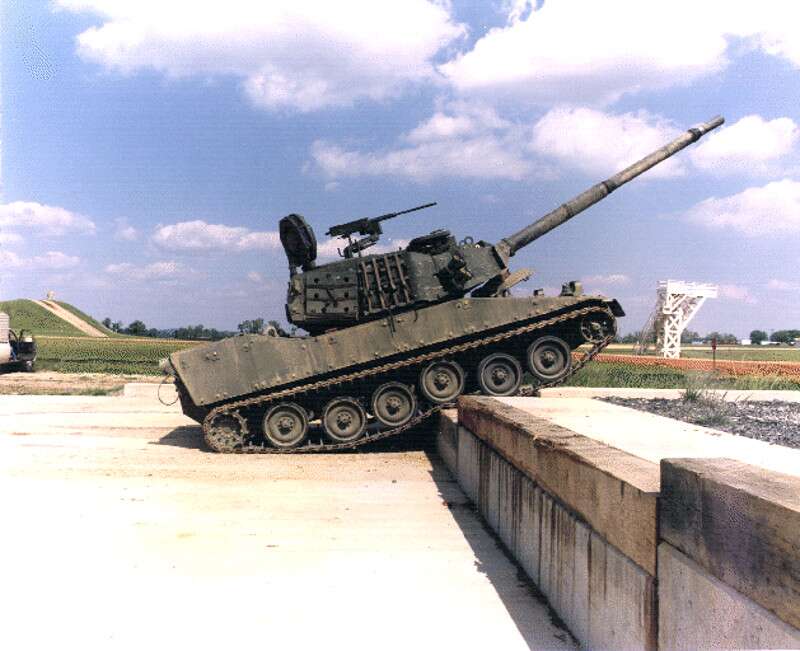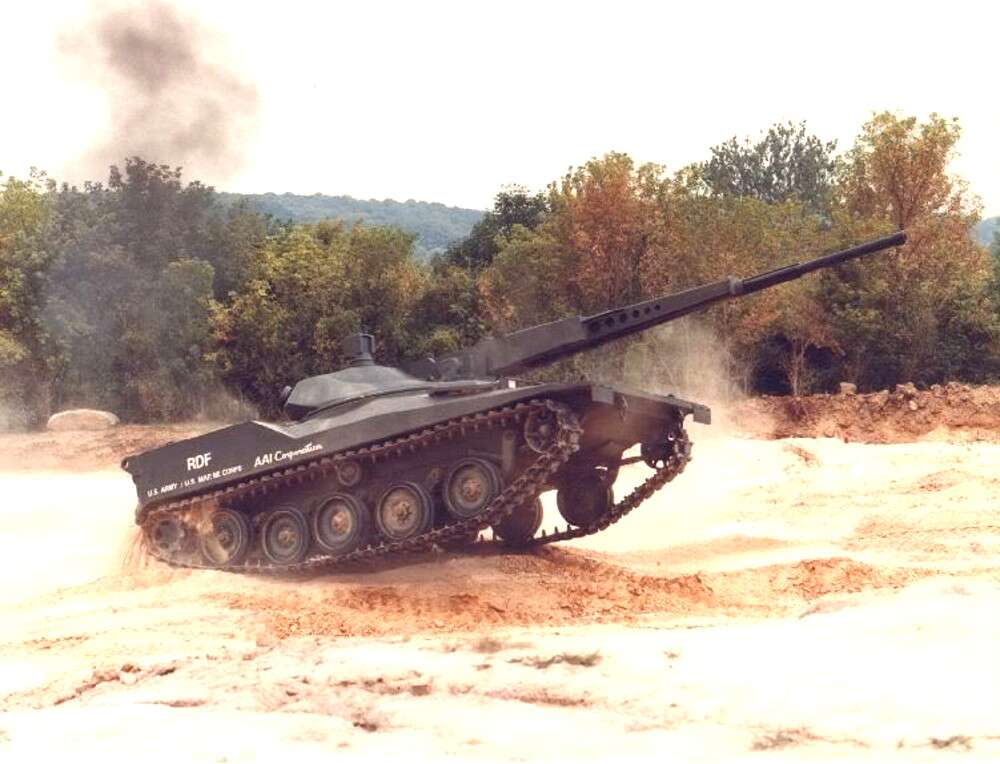
Posted on 11/02/2017 4:02:30 AM PDT by sukhoi-30mki

The U.S. Army is rushing ahead with its project to develop a new light tank to give infantry brigades extra firepower, especially against a near-peer opponent such as Russia. In the past, though, developing a vehicle that is both lighter than a traditional main battle tank and still survivable and useful on a modern battlefield has proven to be a difficult proposition.
The Army plans to send out a final, formal request for proposals for the program, known as Mobile Protected Firepower (MPF), to interested defense contractors in November 2017. The service then hopes to power through the contracting process and pick a winning design during the 2019 fiscal year, which begins on Oct. 1, 2018.
“We expect to be delivering prototypes off of that program effort within 15 months of contract award,” U.S. Army Major General David Bassett, the service’s program executive officer for Ground Combat Systems, said earlier in October 2017. The goal is “is getting it in the hands of an evaluation unit six months after that – rapid!"
The Army has focused discussions of the MPF program heavily on the contracting side of things. After suffering spectacular setbacks in armored vehicle modernization with the cancellation first of the Future Combat Systems (FCS) program and then of the subsequent Ground Combat Vehicle (GCV), the service has been keen to stress that this effort will be different.
Getting the vehicles to units quickly is important because the Army has identified a clear need to improve the firepower of infantry units in particular against a more traditional opponent. After more than a decade of limited, low-intensity conflicts against terrorists and insurgents, the U.S. military has become increasingly concerned it isn’t prepared for a conventional, high-intensity battle.
After Russia seized control of Ukraine’s Crimea region in 2014, subsequently began fighting alongside separatists battling the central government in Kiev, and adopted a broadly revanchist foreign policy, this only became more apparent. Since then, the United States and NATO members have taken up and expanded defensive posture along the alliance’s eastern flank and have experienced increasing harassment from Russian forces and intelligence services.
MPF will follow a number of other similar rapid procurement efforts primarily focused on the European theater of operations, including the development and purchase of an up-gunned Stryker armored vehicle with a 30mm automatic cannon and of a turret for other variants of the 8x8 design that features both a .50 caliber M2 machine gun or a 40mm Mk 19 Mod 3 automatic grenade launcher and a Javelin anti-tank missile system.

US ARMY
Upgunned Stryker
As for the actual requirements for the MPF, the Army appears to have done its best to keep them as opened ended as possible. The design should be able to blast its way though bunkers and other fortifications, attack enemy forces taking shelter in buildings, and destroy various enemy armored vehicles, according to one official briefing.
At the same time it has to be light enough – approximately 25 to 30 tons – to fit inside at least a C-17 Globemaster III transport aircraft, and hopefully even a smaller C-130 Hercules. Since the Globemaster III can already carry a single M1 Abrams, the goal is for a C-17 to be able to deliver two MPFs straight into a combat landing zone. It should be protected against at least small arms and shrapnel air burst artillery rounds, with additional armor kits offering defenses against more powerful threats.

US ARMY
There’s no apparent stipulation that the vehicle has to be tracked rather than wheeled or what kind of main weapon it should have to do its job. Without tracks, it's unlikely the vehicle would be able to negotiate the required obstacles or have the requisite off-road mobility – and it definitely wouldn't qualify as a tank, light or otherwise. The Army would really prefer if you didn’t call it a tank at all though.
"I don't want to say it's a light tank, but it's kind of like a light tank," David Dopp, the MPF project lead, told the service’s reporters in June 2017. “It's not going toe to toe with a tank. …it's for the infantry. It goes where the infantry goes – it breaks through bunkers, it works through targets that the infantry can't get through.”
Its true that from this description, it might be more accurate to call the proposed vehicle an "assault gun," since its not necessarily supposed to take on enemy tanks. So far, though, the three major competitors for the program have presented designs that would look very much like tank to the average person, that is to say a tracked vehicle with a turret armed with a medium caliber main gun that is able to traverse 360 degrees.
In 2016, General Dynamics debuted a vehicle called Griffin as its likely entrant for the MPF program. The design leverages a significant amount for the company’s existing experience, including the hull of the Ajax scout vehicle it is building for the British Army, a turret dervied from the one on the M1 Abrams containing the lightweight 120mm cannon it developed for the FCS project. Internally, the turret has many of the same systems and a nearly identical basic layout as the M1, too, which could reduce how much of an additional training regimen the Army would need to create to get troops qualified to operate the vehicle. The firm said the total package weighed approximately 28 tons.
Then there’s the much smaller team of defense contractor SAIC and Singapore’s ST Kinetics, or STK. The same partnership has already provided 16 Terrex 2 8x8 wheeled vehicles for the U.S. Marine Corps’ Amphibious Combat Vehicle 1.1 program. For MPF, the plan is to provide a version of STK’s Next Generation Armored Fighting Vehicle (NGAFV) armed with the 105mm-gun armed Cockerill 3105 turret from CMI in Belgium. The exact weight of this configuration is unclear.
Lastly there is BAE Systems, which has put forward an upgraded version of its M8 Buford Armored Gun System (AGS), called the Expeditionary Light Tank. This vehicle, weighing in at less than 20 tons in its lightest configuration, also features a turreted 105mm cannon as its main weapon. BAE has already conducted low-level air-drop tests of this design, as well, but its unclear whether or not this is still a core MPF requirement.
"What it will not be capable of is a low-velocity air drop from a C-17," U.S. Army Major General Bassett said earlier in October 2017, according to the service's official report. "Protection and lethality requirements will probably make it heavier than what's acceptable for a C-17 air drop," U.S. Army Major General Bassett said earlier in October 2017.
There is always the possibility that additional competitors may submit bids after the final requirements become available. At the Association of the U.S. Army's main annual conference and exhibition earlier in October 2017, South Korean conglomerate Hanwha displayed a model of a design based on its K21 armored fighting vehicle that also uses the Cockerill 3105 turret.
In theory, adding any one of these vehicles to the Army’s infantry brigades and providing it air-landed option for airborne forces could increase the capability and flexibility of those forces. At present, the largest combat vehicle available to those units is a High Mobility Multipurpose Wheeled Vehicle, or Humvee, with an M2 machine gun, Mk 19 grenade launcher, or TOW missile launcher.

JOSEPH TREVITHICK
A model of South Korean conglomerate Hanwha's K21-105 light tank.
These troops will eventually receive new Joint Light Tactical Vehicles, but the armament options may very well be the same. The Army is considering adding a 30mm cannon to some of these 4x4 light trucks in certain units, but this would not have anywhere near the capability to blast fortifications or take on larger armored vehicles the service expects from MPF.
With a larger armored vehicle, light infantry and airborne units would have a more powerful answer to enemy forces with those own similar capabilities or hunkered down behind heavy cover, especially in urban areas. Advances in programmable, multi-purpose large caliber ammunition mean that the vehicles may even be able to take on many of these targets with just one type of shell.
As it stands now, these units must rely on M1 Abrams from nearby armored formations or air support to provide this type of capability, which might not always be forthcoming in a crisis. In addition, the M1 might not be able to navigate narrow streets, small bridges, or generally dense urban environments, especially those troops might regularly encounter during a conflict in Europe.

US ARMY
The same technology that has gone into the 120mm Advanced Multi-Purpose tank round could make any future Mobile Protected Firepower vehicle even more flexible.
The MPF would be “essential to defeating local fortifications, point defenses, and blocking positions to maintain momentum,” the Army explained in a combat vehicle modernization white paper in 2015. “Without the combat vehicle, the infantry [brigade combat team] requires reinforcement with heavier armored vehicles for close combat against capable enemies.”
More pointedly, in 2016, the RAND Corporation estimated it would take heavy armored Russian forces less than a week to steamroll over American and other NATO forces in the Baltic States of Estonia, Latvia, and Lithuania. This was in no small part due to the lack of available anti-tank weaponry among friendly forces or vehicles protected to any serious degree against massed artillery fire.
Underscoring this potential threat, in September 2017, thousands of Russian and Belorussian troops took part in a massive exercise, called Zapad, or West, which occurs every four years. Though the Kremlin insisted it was purely defensive in nature, the goal was to demonstrate the capability of the two countries to conduct large scale operations across a wide area against a notional major opponent, which most experts assume is a stand-in for NATO.
So, the requirement for a system like MPF is definitely there. The only problem is whether there is a design that truly meets the Army’s requirements or whether it will have to water down its wish list, resulting in vehicle that has limited utility on any battlefield.
To drive the point home, there’s a reason why BAE Systems had a design that it could simply update in the first place. The basic MPF requirements sound very similar to those that led to the development of the original M8 in the 1990s. United Defense crafted the Buford before the Army cancelled the program ostensibly in response to post-Cold War budget cuts in 1996. In 2005, BAE bought the company.
But it was never clear that the AGS concept was truly workable. When it scrapped the project, the Army was facing criticism that the M8 was too vulnerable in its lightest configuration and at the same time too heavy and bulky to be air-dropped or fit inside a C-130 with the protection offered by its heaviest add-on armor package.

US ARMY
The M8 Armored Gun System navigates an obstacle at Aberdeen Proving Ground during tests in the 1990s.
By the mid-1990s, the Army had already been struggling with what it really wanted from a light tank for more than three decades. The M8 was supposed to have been a direct replacement for the last such vehicle, the M551 Sheridan, which entered service in 1969.
The Sheridan itself remains a prime example of “feature creep” in weapon design, as engineers attempted to make an over-ambitious multi-purpose tracked vehicle to fill the job of an “armored reconnaissance/airborne assault vehicle” or AR/AAV for armored cavalry and airborne troops. The final M551 weighed just more than 15 tons, was supposed to be able to swim across rivers and lakes, and featured a futuristic and lightweight 152mm combined gun-and-missile launcher that was supposed to make up for the lack of space for a traditional tank cannon.
To fit this into a package that the Air Force could drop from a C-130, it had exceptionally little armor and could barely withstand the recoil of its main weapon. Firing the huge cannon had an above average chance of destroying the M551’s sensitive missile targeting system, as did dropping the vehicle out of an airplane, essentially defeating the entire purpose of using the combination weapon.
The vehicle had, at best, a mixed reception from cavalry soldiers who put it to use first in Vietnam. Its 152mm gun could fire a massive anti-personnel shell, but it was vulnerable to even light anti-tank weapons and had little if no real protection against land mines.
In 1989, the Air Force air-dropped 10 of them during the U.S. intervention in Panama, destroying two in the process. In 1991, the 82nd Airborne brought them to Iraq during the first Gulf War, where reportedly some of them actually employed their Shillelagh anti-tank missiles for the first and last times in combat. There is no indication that any of the vehicles killed any Iraqi T-55s or T-72s.
The M8 AGS was supposed to rectify the failings of the M551 and incorporate lessons learned from various experiments in unconventional vehicle design during the 1970s and 1980. During that period, the Army had explored lightweight vehicles with unmanned turrets, including that could elevate its main gun to fire from behind cover, and smaller, high velocity cannons.

AAI
One of AAI's Rapid Deployment Force Light Tank prototypes with a 75mm high velocity cannon.
As the AGS program progressed, though, the vehicles requirements grew and so did its size, a theme the Army ran into again with FCS and then GCV, the latter of which had ballooned to 84 tons, more than an M1 Abrams tank, before that project ended. The M8 project itself morphed into the much maligned wheeled Stryker Mobile Gun System (MGS) variant, which has weathered its own criticism of being too lightly armored, too heavy for widespread use, and unable to properly withstand the shock of firing its special medium-velocity 105mm cannon.
Contractors can and are seeking to use as many existing and off the shelf components to reduce the risk of delays and keep costs down, but these efforts can’t stop the laws of physics. With the relatively open-ended requirements and the need for MPF to protect against steadily emerging threats, including, but not limited to the proliferation of advanced, man-portable guided anti-tank missiles and small drones, the Army will have to keep a close eye on the MPF development to avoid more feature creep and weight growth.
With the Army already talking about add-on armor, one of the factors that doomed the Buford, protective features will be a particularly important consideration. The MPF competitors could choose to sacrifice passive armor in favor of an active protection system to help keep weight down. The Army is already buying Israel’s Trophy system for its M1 tanks and is considering lightweight versions of it, as well as other systems, for other vehicle types.
The Army might not be willing to give up too much conventional protection, though, since hard-kill defenses have a limited number of shots before they have to be reloaded, something best done off an active battlefield. There's always the danger that nearby troops could find themselves in the path of the intercepting projectiles, too. The service could always decide to accept different kinds of risk by relying more on active protection, something it has already suggested it is trying to convince tankers as part of the decision to add Trophy to its Abrams.
“There has to be a level of trust in whatever it is that you're trying [to use] to displace that passive armor,” U.S. Army Lieutenant General John Murray, Deputy Chief of Staff for Resource Management, told industry representatives in March 2017. The officer wasn't sure then that troops had real confidence in active protection.
An ammo-less system such as an electronic warfare system might be a better solution, but Jammers might not have the same effect on all incoming projectiles or could block friendly communications or other systems. Combining electronic warfare equipment with an active protection arrangement could help mitigate their individual disadvantages, but both would still have risks for nearby troops. New training and tactics could reduce the chances of any sort of friendly fire.
The use of lightweight composite materials for portions of the vehicle’s construction or the employment of a similarly compact hybrid propulsion system its with reduced fuel requirements could free up trade space, as well, if the MPF final requirements call for defensive or other systems. Again, though, many of the applicable technologies are relatively young, especially in terms of their utility on an armored vehicle for use in a combat scenario.
With the Army insisting on such an aggressive schedule, we won’t have to wait long to see if the prototypes stay relatively the same shape once BAE, General Dynamics, and SAIC and ST Kinetics get their hands on the final requirements.
Wasn’t there something like that in a Hogan’s Heroes episode?
Ping
The tank seems like the land version of the battleship. The battleship became obsolete when aircraft came on the scene, and a big, expensive ship could be sunk by a swarm of small, relatively inexpensive planes. I think we may soon see something similar happen to tanks.
I can see cheap, mass-produced, unarmored drones dominating the future battlefield. Thousands of small sensor drones crawl or fly around the battlefield looking for the enemy. When they find an enemy, a quad-copter with either a machinegun or missile launcher quickly shows up and kills the enemy. If one gets taken out, it is quickly replaced by another cheap expendable drone.

Complete with bud vase to keep cisfems and transfems in their happy space...

" Soldier On! in Fabulous Style."
Must-see movie “The Pentagon Wars”
It describes this process.
So they want a light tank? Sort of like they wanted a light tank with a big “gun” and came up with the Sheridan?
I guess enough generations have passed that this can become a new idea again.
Paging Sir Issac Newton. Please pickup the camouflaged courtesy phone.
These idiots need some remedial instruction.
In other words, what the US Army wants is an assault gun. They’ve gone back to Wehrmacht thinking of the mid-1940s.
JMO, but I don’t think they’ll meet the protection needs and weight limits with a turret on a tracked vehicle. The gun armament will have to have limited elevation/traverse.
Another thing: tracks get pretty maintenance intensive. Years ago, the Army figured out anything less than a four-man crew on a tank ended up with maintenance problems in peacetime, and watch problems in wartime.
That’s before I have my doubts about Pentagon procurement officials bringing in the project on-time and on-budget.
Army still seeking a “light” tank.
I was thinking the same thing.
LOL LOL LOL
or NROK Pres FAT Kim un in it.
Maybe it’s time to get those laser and missile armed dune buggies from Megaforce out.
OH, ..What a Grand PineWood Derby Car soe Cub Scouts that wood make. LOLlollLOLlol USING 3 WHEELS OF COURSE,
Thanks for the ping. If I recall, light tanks haven’t survived well in combat.
That AAI looks downright Russian in design.........
Disclaimer: Opinions posted on Free Republic are those of the individual posters and do not necessarily represent the opinion of Free Republic or its management. All materials posted herein are protected by copyright law and the exemption for fair use of copyrighted works.